Travelling with Tiny Guitars
Posted by Dylan Beattie on 24 July 2023 • permalinkLast week Jakub Gutkowski asked on Twitter:
@dylanbeattie hey, what travel guitar (when you fly etc) are you using? Thanks!
Sounds like a really good opportunity to geek out about guitars for a bit.
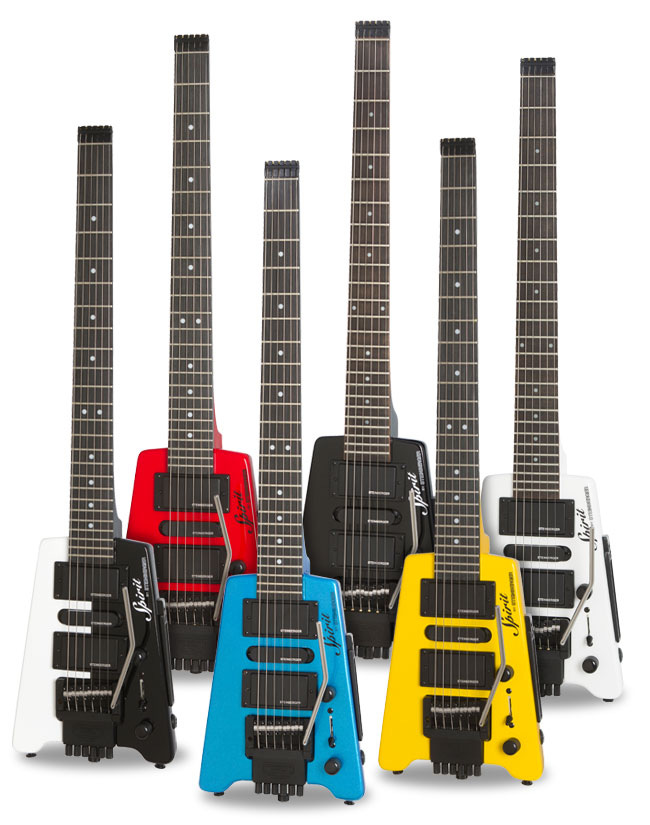
The current Steinberger Spirit guitar line-up. Gotta catch ‘em all… right?
My travel guitars — I currently own two — are Steinberger Spirit GT-PROs, and there’s a bit of history behind them. They were originally designed by a guy called Ned Steinberger in the 1980s. Steinberger was a true innovator; while most guitar companies were churning out the same wooden solid-body guitar in various different shapes and colours, Steinberger’s guitars were made of carbon fibre. To eliminate the headstock, he moved the tuning machines into a special bridge, and built his guitars to use specially built strings with a brass ball at both ends.
Personally, I think Steinberger’s greatest innovation was a thing called the “TransTrem”. See, the tremolo on most guitars will let you wobble the strings around a bit, get some gentle vibrato or a screeching “dive bomb” effect — but when you do, every string detunes by a different amount. The TransTrem used calibrated strings so when you grabbed the trem bar, the strings stayed in tune relative to each other — if you want to see one in action, check out “Get Up” by Van Halen, from the 5150 album; here’s a live clip from a 1986 show showing Eddie van Halen playing one of his custom red-striped Steinbergers, complete with liberal use of the TransTrem:
Steinberger sold the company to Gibson in 1987, who continued to manufacture the guitars until the mid-1990s. Then grunge happened, everybody got really miserable, the music industry unilaterally decided that the 1980s had been a horrible mistake, and Steinberger guitars went out of production for a while.
Life, the Universe, and… Guitars?
I had no idea any of this was going on; I think I might have seen a Steinberger on Top of the Pops once or twice, but I couldn’t have told you what it was called or anything more about it. Then, during the 1990s, the Guardian newspaper in the UK ran a short-lived column called “Me and My Gizmo”. They’d interview celebrities about a particular tool or piece of technology they loved — explorers talking about their Swiss Army knife, chefs talking about a piece of kitchen equipment. One week, the featured guest was Douglas Adams, talking about his favourite guitar: a white, left-handed Steinberger.
I’ve been a huge fan of Douglas Adams since I first read The Hitch-Hiker’s Guide to the Galaxy when I was a kid. I love his writing, I love his fascination with technology and gadgets… and it turned out he was also a huge guitar nerd. I clipped out the column, and it was pinned up above my desk in my bedroom for years. That original clipping went missing somewhere among my many undergraduate house moves, but with a bit of help from the lovely folks at ZZ9 Plural Z Alpha, I managed to track down a copy via the newspapers.com online archive. I’ve reproduced it here:
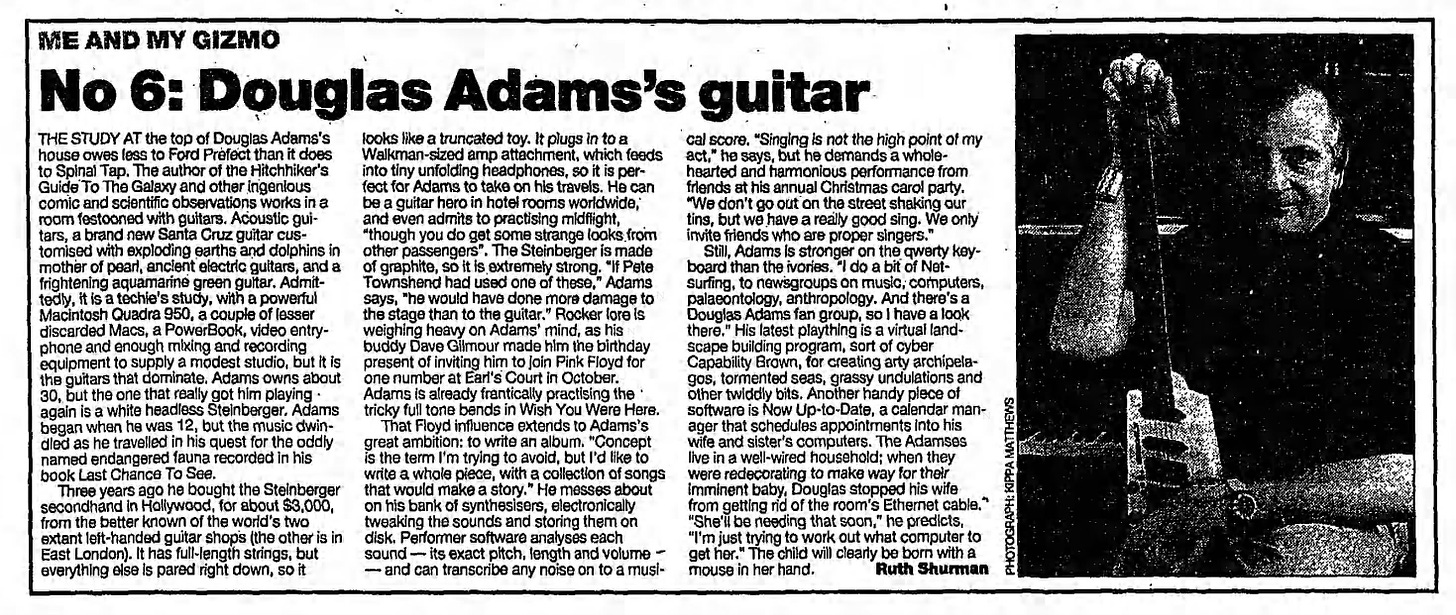
“ME AND MY GIZMO No 6: Douglas Adams’s guitar”, The Guardian, June 23, 1994
THE STUDY AT the top of Douglas Adams’s house owes less to Ford Prefect than it does to Spinal Tap. The author of the Hitchhiker’s Guide to the Galaxy and other ingenious comic and scientific observations works in a room festooned with guitars. Acoustic guitars, a brand new Santa Cruz guitar customised with exploding earths and dolphins in mother of pearl, ancient electric guitars, and a frightening aquamarine green guitar. Admittedly, it is a techie’s study, with a powerful Macintosh Quadra 950, a couple of lesser discarded Macs, a PowerBook, video entryphone and enough mixing and recording equipment to supply a modest studio, but it is the guitars that dominate. Adams owns about 30, but the one that really got him playing again is a white headless Steinberger. Adams began when he was 12, but the music dwindled as he travelled in his quest for the oddly named endangered fauna recorded in his book Last Chance to See.
Three years ago, he bought the Steinberger secondhand in Hollywood, for about $3,000, from the better known of the world’s two extant left-handed guitar shops (the other is in East London). It has full-length strings, but everything else is pared right down so it looks like a truncated toy. It plugs in to a Walkman-sized amp attachment, which feeds into tiny unfolding headphones, so it is perfect for Adams to take on his travels. He can be a guitar hero in hotel rooms worldwide, and even admits to practising mid-flight, “though you do get some strange looks from other passengers”. The Steinberger is made of graphite, so it is extremely strong. “If Pete Townshend had used one of these,” Adams says, “he would have done more damage to the stage than to the guitar.” Rocker lore is weighing heavy on Adams’s mind, as his buddy Dave Gilmour made him the birthday present of inviting him to join Pink Floyd for one number at Earl’s Court in October. Adams is already frantically practising the tricky full tone bends in Wish You Were Here.
That Floyd influence extends to Adams’s great ambition: to write an album. “Concept is the term I’m trying to avoid, but I’d like to write a whole piece, with a collection of songs that would make a story.” He messes about on his bank of synthesizers, electronically tweaking the sounds and storing them on disk. Performer software analyses each sound – its exact pitch, length and volume – and can transcribe any noise onto a musical score. “Singing is not the high point of my act,” he says, but he demands a whole-hearted and harmonious performance from friends at his annual Christmas carol party. “We don’t go out on the street shaking our tins, but we have a really good sing. We only invite friends who are proper singers.”
Still, Adams is stronger on the qwerty keyboard than the ivories. “I do a bit of Net-surfing, to newsgroups on music, computers, palaeontology, anthropology. And there’s a Douglas Adams fan group, so I have a look there.” His latest plaything is a virtual landscape building program, sort of cyber Capability Brown, for creating arty archipelagos, tormented seas, grassy undulations and other twiddly bits. Another handy piece of software is Now Up-to-Date, a calendar manager that schedules appointments into his wife and sister’s computers. The Adamses live in a well-wired household; when they were redecorating to make way for their imminent baby, Douglas stopped his wife from getting rid of the room’s Ethernet cable. “She’ll be needing that soon”, he predicts, “I’m just trying to work out what computer to get her.” The child will clearly be born with a mouse in her hand.
- Ruth Shurman
Douglas Adams died in 2001. Then in 2015, his original white Steinberger showed up for sale on eBay and somebody sent me a link going “hey, look, you can buy Douglas Adams’s guitar!”
There were only two problems: one, I wasn’t left-handed1, and two, I didn’t have three and a half grand knocking around. It got me thinking, though. This was around the time that I started travelling to tech conferences abroad, and writing tech parody songs, and putting them up on YouTube; I’m not saying I needed a travel guitar, but I really, really wanted one — and if it could be a white Steinberger like Douglas’s one, then so much the better. So I did a little digging.
The Steinberger Spirit revival
Turns out Gibson had started making Steinberger-style guitars again in the early 2000s, under the “Spirit” model name. Now, the Steinberger Spirit is a very, very different beast from the original 1980s guitars. They’re made of wood rather than carbon fibre, they don’t have the transposing tremolo, they don’t have active pickups, and they’re not made in the USA… and they cost a few hundred pounds, rather than several thousand.
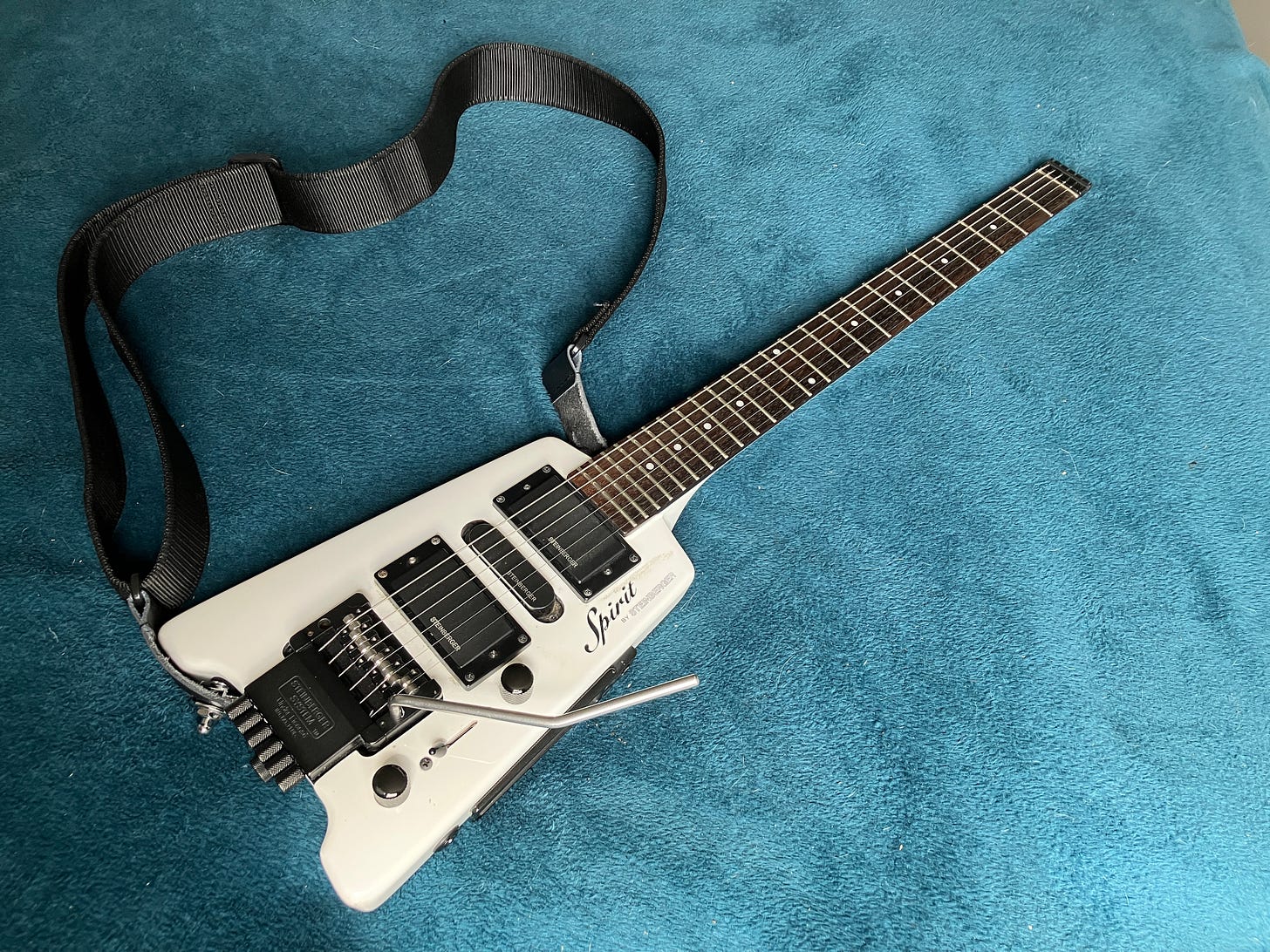
My white Steinberger Spirit GT-PRO.
I bought my white Steinberger from Guitar Guitar in Epsom in 2016 for £299. It was love at first strum: I plugged it in, played it for about thirty seconds, and that was it. That guitar’s been to Australia twice, seven trips to Russia, six trips to Ukraine, the USA, Belarus, Israel, and dozens of shows all over Europe — if all those trips were in a straight line it’d be three quarters of the way to the moon by now. I’ve swapped out the regular strap buttons for Straplocks, and moved the neck strap button on to the top shoulder of the body, but apart from that it’s completely stock.
The first few trips I did with this guitar, I took it in the cabin with me, but flying with a guitar — even a tiny travel one — is a bit of a grey area. Technically, it’s not allowed, because it exceeds the cabin baggage allowance. I’ve never been stopped, but I’ve also never been explicitly told it’s OK… it was always a case of smile, don’t ask, and hope it works out, and I was never entirely sure what I would do if it didn’t work out.2
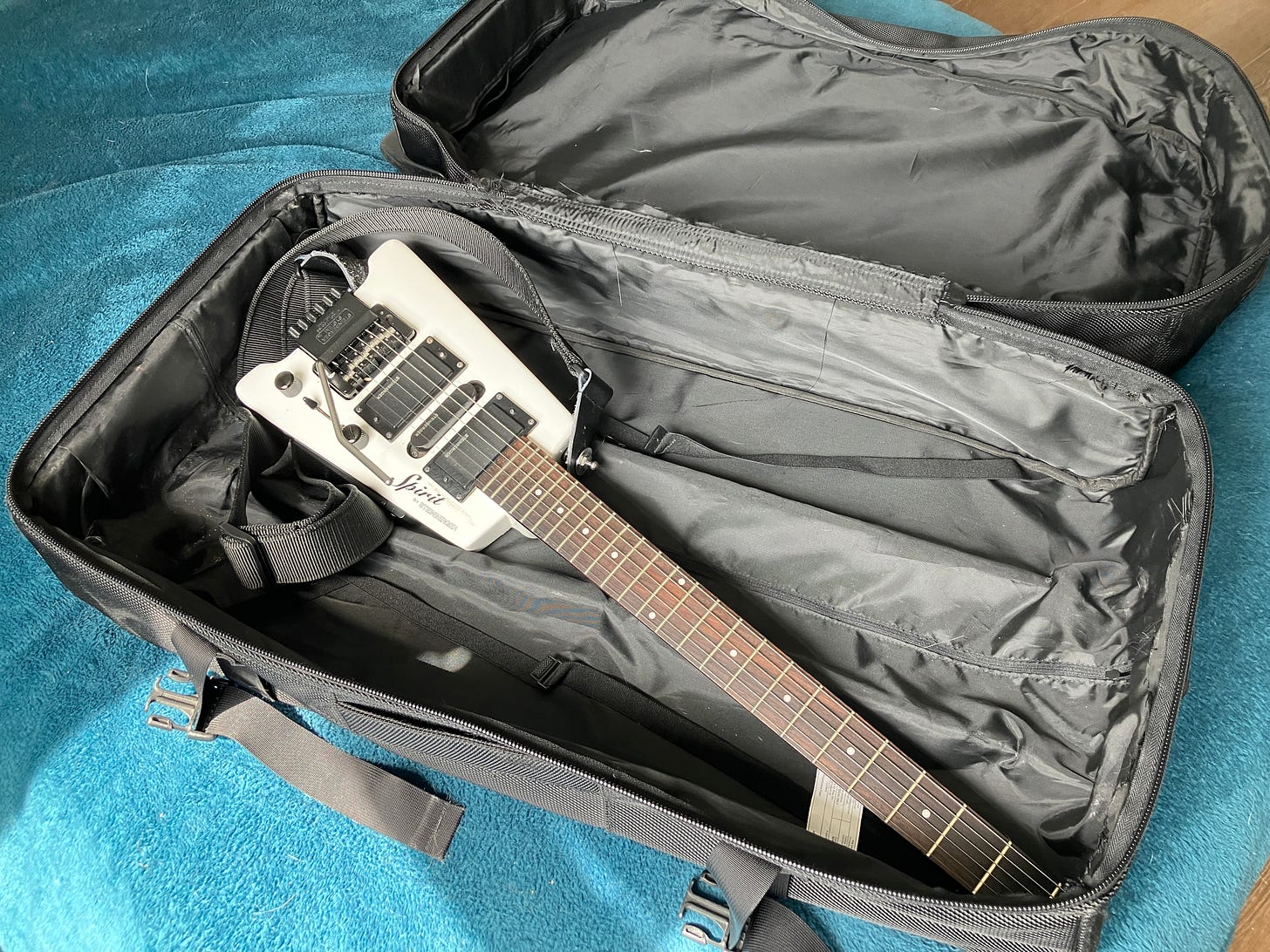
These days, it goes in the hold. I have an Eastpak roller duffel case which is big enough to stash my guitar in the bottom, solid enough to keep it safe in transit, and small enough to check as regular baggage, so most trips the guitar goes in the big case with clothes packed around it, and the aluminium flight case with my mixing desk, wireless gear, etc. shoved in the top.
Yeah, checked baggage doesn’t always arrive in the right place at the right time. I’ve been remarkably lucky with air travel — the only time my bag ever went missing was on the way home from St. Petersburg a few years ago, and I got a phone call less than an hour after I left the airport to say they’d found it. Still, it’s a risk, so a year or so later, I went shopping for a backup guitar in case the primary guitar went walkabout.
Turns out that the supply chain for these guitars can be a little volatile: none to be had in guitar stores, for love nor money. Eventually I tracked down a second-hand one, but trying to keep it in tune gave me all kinds of headaches. Turns out there was a huge crack in the tremolo block, which was slowly bending out of shape under the tension of the strings, and eventually snapped off altogether.
That one hung on the wall for a long while, until earlier this year, I decided to overhaul it: a new EVH-inspired paint job, new electrics, a replacement tremolo block, and a headstock adapter so I could use regular strings with it instead of special Steinberger double ball-end strings.
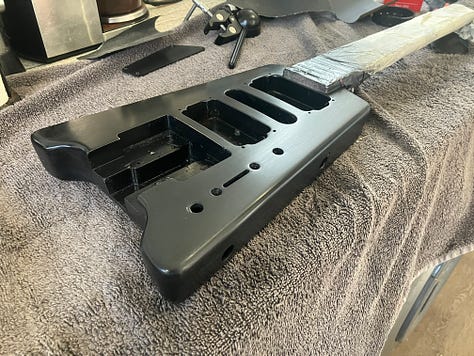
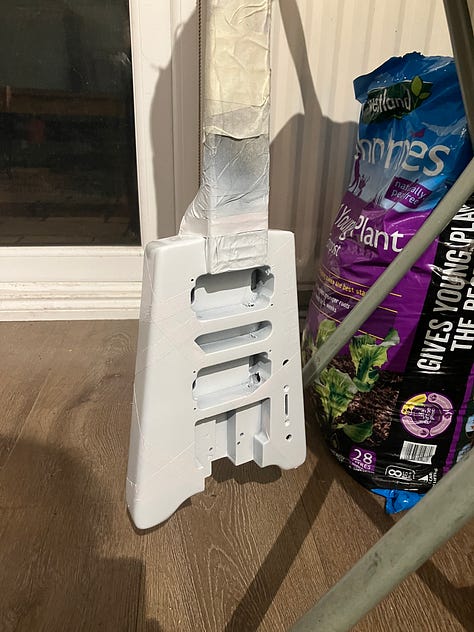
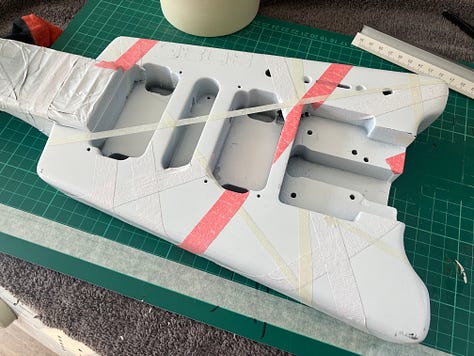
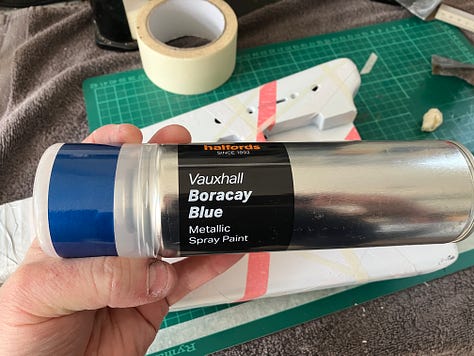
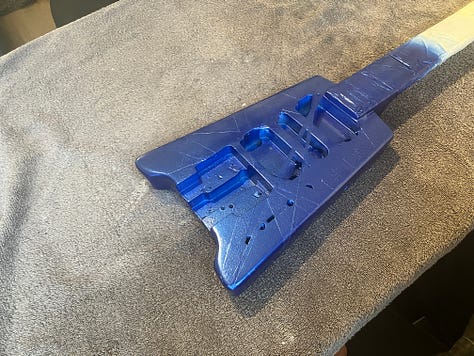
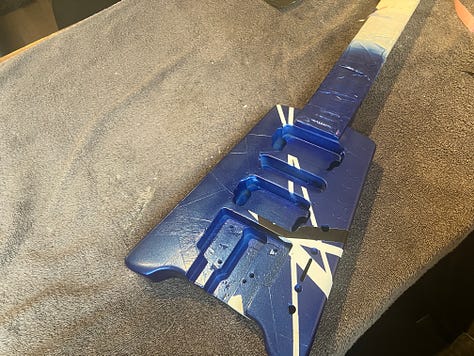
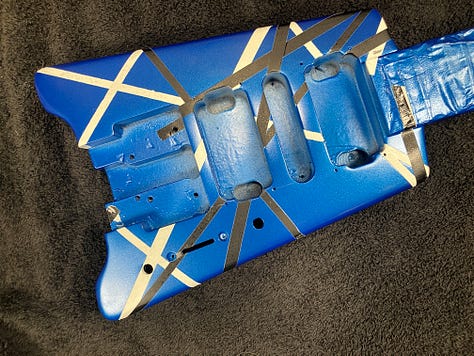


Overhauling a Steinberger Spirit GT-PRO guitar.
I’m really happy with the new paint job and the electrics… but the new trem block and the string adapter, not so much. It’s not easy to find authentic Steinberger replacement parts, so I ordered after-market replacements which are apparently made by OVERLORD OF MUSIC, and, well, they’re terrible. The string adapter lasted about four hours before tuning problems drove me to put the original headstock back on, and I ended up completely dismantling the new tremolo assembly and rebuilding the original around the replacement block from the new one, and I’m still not entirely convinced.
Replacement part woes aside, they are genuinely wonderful guitars. They’re fun, they look fantastic, they sound great and play remarkably well considering they retail for under £500. Given that the famously fickle supply chain appears to be firing on all cylinders right now, I suspect that before long I might end up buying another one.
After all, no matter how many guitars you already have, the ideal number of guitars to own is N+1.
1 I’m still not, in case you’re wondering.
2 On my fourth, maybe fifth, trip to Russia, the attendant at the airline check-in desk told me that “guitars were not allowed on flights to Russia”. I explained I’d taken the same guitar on the same airline several times before. She said that wasn’t allowed. I thanked her for the information and said I’d remember it for next time. She handed me my boarding pass, and that was that. Even at the best of times, Russian bureaucracy never made the slightest bit of sense.
